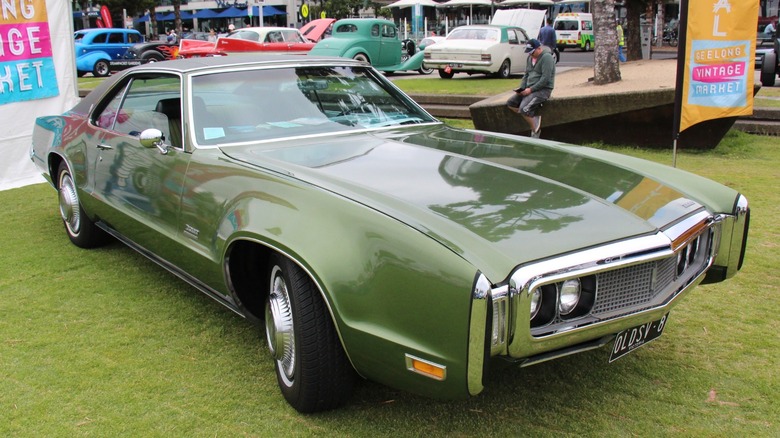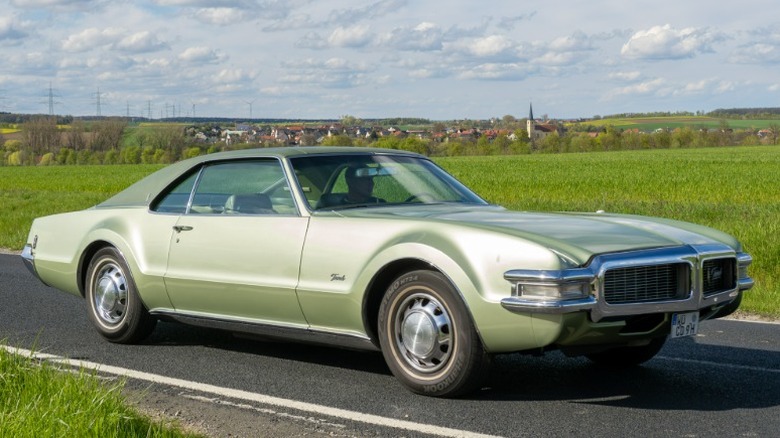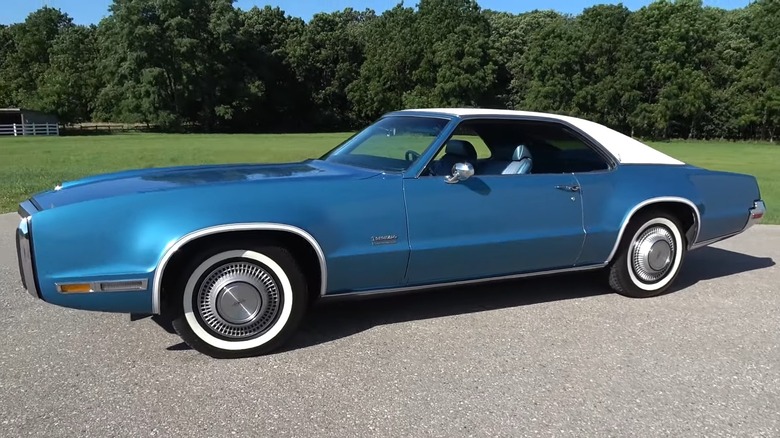What Was The Most Powerful Oldsmobile To Ever Make It To A Showroom Floor?
When most people picture an Oldsmobile, they probably don't think of something fast. More often than not, these vehicles are known for being rather pedestrian sedans and coupes, typically owned by middle-aged suburbanites who own them for five years before trading them in for a newer model. That isn't necessarily bad, by any means, but it certainly doesn't conjure up any notions of high performance.
Despite that, Oldsmobile boasts a proud history of producing fast cars. Its 1960s lineup, in particular, features several handsome performance cars with the power to match, like the Olds 442, a car sadly discontinued after becoming a shadow of its former self. But even the mighty 1968 Hurst/Olds 442, with its 390-hp, 455-CI engine, wasn't the most powerful Oldsmobile to ever be available in a showroom. That title goes to something far more luxury-oriented.
Enter the 1968-1970 Oldsmobile Toronado, a front-wheel drive luxury muscle car boasting 400 hp from the 455 big block, the most ever seen on an Oldsmobile from the factory. Unlike the 442, however, this was no sports car; instead, it was a personal luxury car, built with subdued refinement in mind. Its base-level engine alone featured some 375 hp, a substantial number for a front-wheel-drive coupé, though it wasn't built to be fast. Rather, its design emphasized smoothness, comfort, and long-distance performance, similar to contemporary rivals like the Ford Thunderbird and Buick Riviera. Let's dive into the story behind this uniquely quirky and often-forgotten automobile, its influence on the automotive industry, and its distinctive engine.
The Toronado was a powerful technological marvel
While a front-wheel drive luxury car doesn't sound particularly special today, the Toronado was seen as groundbreaking, stylish, and comfortable back in 1966. So comfortable, in fact, that "Motor Trend" critics voted it the publication's Car of the Year, in part thanks to its comfy ride. It became the first mass-produced front-wheel-drive car in the U.S. since 1937, with a production run that lasted from 1966 to 1992. It was originally marketed as a combination of luxury and performance, boasting advanced features for the time, such as power brakes and steering, front disc brakes, factory air conditioning, electric seats and windows, and thick padded seats. Yet Oldsmobile didn't skimp out on power, either; the 1966 model came with the 425-CI Rocket V8 before Olds introduced the 455.
The crowning achievement of these first-generation Toronado models, however, was the styling. These were exceptionally clean-looking vehicles, with pronounced wheel arches, flowing lines, and a distinctive, sleek coupé body with fold-out headlights in early models. Its hood line was purposefully long, housing the big-block with room to spare for the specialized FWD arrangement, which links to a transaxle and differential on the left-front side of the car. Despite utilizing the most powerful engine ever featured in Oldsmobile's lineup, the Toronado's power was more of a necessity, considering the package it moved weighed in at 4,200 pounds. Let's open the hood next and see what makes the engine itself special.
The most powerful, but not the fastest -- though it didn't need to be
While the Toronado represented Oldsmobile's most powerful offering on paper, this was by no means a dedicated sports car like a Corvette or a muscle car like a 442. Grand tourers, in principle, are effectively personal luxury coupes. Generally speaking, a grand tourer offers a combination of performance and comfort, with a powerful engine housed in a well-appointed 2+2 body style and a focus on driving dynamics. As such, the Toronado's engine was designed to meet those particular needs, as opposed to making it the fastest car on the block; that title goes to the Hurst/Olds 442. Despite having less horsepower than the Toronado, the 442 was significantly lighter and thus sportier than the Toronado.
As for the engine itself, the 400-hp 455 in the 1968-1970 Toronado utilized a "Force-Air Induction System," not to be confused with forced induction (turbochargers or superchargers). This bumped its 375-horsepower rating up to 400 via cold-air induction, a high-output camshaft, and dual exhaust. It also featured a higher axle ratio. Otherwise, the engine itself was identical to the standard Olds 455.
While its many innovations frequently overshadow the power figure, the Olds Toronado nevertheless remains a seminal vehicle for the defunct brand. Its styling, powertrain, and grand tourer appeal rank it among the most underappreciated Oldsmobiles of the 1960s and beyond.


